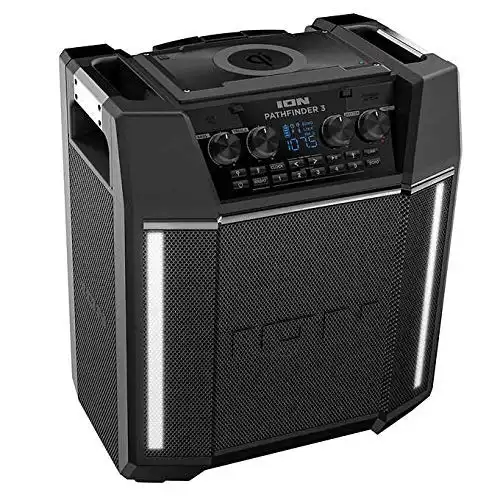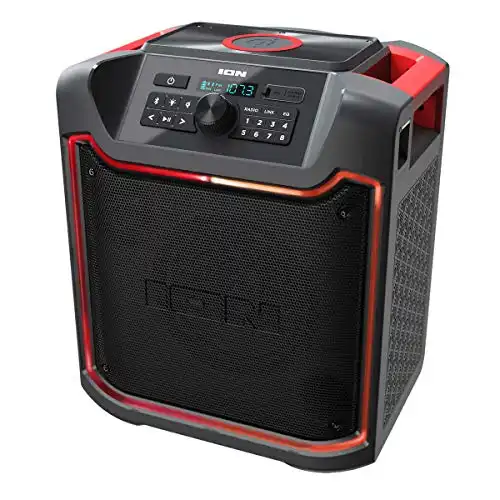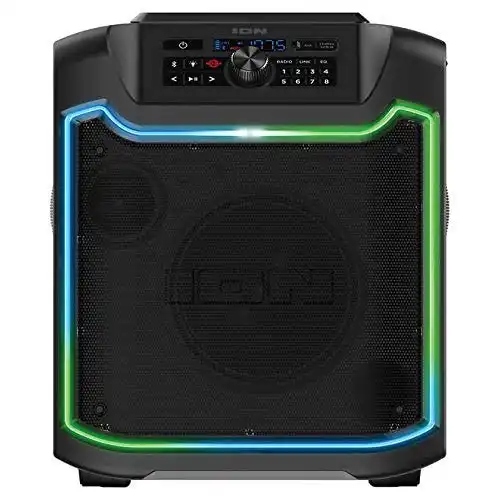Summary
Ion Pathfinder speakers are a solid choice for anyone seeking a budget-friendly party speaker.
If you are able to spend $300-$1,000, there are many great party speakers available, such as the JBL PartyBox series.
But if your budget is limited to $200 or less, your options are fewer.
The Ion Audio Pathfinder series, whether you choose a Pathfinder 3, Pathfinder 4, or Pathfinder 280, all provide major volume and power alongside party lighting and some other cool features.
These aren’t perfect speakers by any means. The battery wears down over time, Ion only provides a 90 day warranty, and the app is nearly useless. But if you need a speaker with massive output, solid sound quality, a power bank feature, and built-in lights, Ion Pathfinders are probably your best bet in the price range.
Continue reading for a discussion of the similarities and differences between the Pathfinder 3, Pathfinder 4, and Pathfinder 280, as well as a guide to help you decide which speaker is right for you.
~~~ Check Price: Pathfinder 3 ~~~
~~~ Check Price: Pathfinder 4 ~~~
~~~ Check Price: Pathfinder 280 ~~~
Pathfinder 3 vs. 4 vs. 280: A Quick Comparison
If you don’t want to read this entire article, here is the shortened version:
- Ion Pathfinder 3 is the only speaker on the list that has a mic input. It also comes with an included microphone. For karaoke, this is probably your best option.
- Pathfinder 4 is an updated version of the Pathfinder 3, and features app-compatibility and more full, stylish party lighting. But you lose the mic input (and mic itself) by upgrading from the 3 to the 4.
- Pathfinder 280 is the most feature-dense of the three. It has the improved lighting and app-compatibility of the Pathfinder 4. But Pathfinder 280 also adds side speakers to create 280 degree sound, as well as a water-resistant storage compartment for your wallet and keys.
Design
All three devices are similar in a number of ways. Each is a powerful party speaker that weighs in around 26 pounds and features a built-in handle and wheels for portability.
An IPX5 rating ensures that you can get the speaker wet without doing damage, though it shouldn’t be totally immersed in water or left out in the rain.
The speakers have a power bank feature, which allows you to use the speaker battery to charge your cell phone or other device. In addition to USB charging a phone, these speakers also feature Qi wireless charging. This means that you can wirelessly charge a compatible phone, using the charging pad located on top of the Pathfinder speaker.
Each version also includes some clever features like a built-in bottle opener and lights on the face of the speaker that can pulse with the music. An FM radio is built in, and the device has buttons that let you save presets.
Earlier versions of the Pathfinder were designed to be karaoke speakers, but Ion has gone away from this design in recent iterations. As such, the Pathfinder 3 is the last version of the speaker that includes a mic input. As mentioned above, the product also comes with an included wired microphone. It is possible to find a bluetooth microphone or adapter that would allow you to use the Pathfinder 4 or Pathfinder 280 as a karaoke speaker, but we wouldn’t recommend it. If you need a microphone, your best bet is to find a Pathfinder 3.
The Pathfinder 3, 4, and 280 are all bluetooth enabled. But Ion included a 3.5 mm aux input on each speaker, also. Having this wired connection can be beneficial in a number of ways. For a party speaker, it may be easiest to plug a phone into an aux cable rather than trying to connect multiple phones to a speaker via bluetooth. Additionally, if you want to use the speaker with a home theater system (such as an outdoor movie projector), a wired connection will have less latency (lag time) than bluetooth.
Other than the microphone and mic input, Pathfinder 3 and 4 are very similar products. The lighting is upgraded on the Pathfinder 4, with lighting surrounding the entire face of the speaker, rather than the two simple bars of lighting on Pathfinder 3. The Pathfinder 4 is compatible with the Ion Sound XP app, whereas Pathfinder 3 is not app-enabled. Otherwise, there aren’t any significant changes to speak of.
Pathfinder 280 has similar upgraded lighting to Pathfinder 4, and is app-compatible like Pathfinder 4. But the 280 adds side speakers for a more immersive audio experience. Ion advertises the speaker as having “280 degree sound.” Pathfinder 280 also includes a water-resistant storage compartment at the top of the device, underneath the wireless charging pad. This allows for convenient storage of your keys, wallet, and other small items.
As previously mentioned, the overall design is very similar for every speaker in the Ion Pathfinder series. These are sturdy, heavy party speakers. Lights on the speaker pulse to the beat of the music and add to the experience. And each speaker has controls to adjust bass and treble, allowing you to customize the sound to your preference.
Battery life on each Pathfinder is advertised as “up to 100 hours.” Honestly, we have no idea how Ion came up with this number. We will have an in-depth discussion of battery life later in this article, but suffice it to say, you shouldn’t expect anything close to 100 hours of use between charges.
Sound
Each Pathfinder discussed here is a powerful 120 watt speaker with an 8 inch woofer and one (or more) 3 inch tweeter(s).
The sound profile is similar for each speaker. These aren’t hi-fi speakers that have the clarity of a Sennheiser. And if you are looking for an easy-listening, classical music experience, these aren’t the speakers for you.
Instead, Ion Pathfinder speakers provide major volume and output power. They have a typical “party speaker” sound profile — meaning that clarity (especially in the mid-ranges) is sacrificed to create a booming, bass-heavy listening experience. Some distortion is present when the volume is cranked up, but this is to be expected with a sub-$200 speaker that gets as loud as Ion Pathfinders do.
As long as you are realistic about what the speaker is and isn’t, you will be pleased with the sound quality of each speaker in the Ion Pathfinder series. These are great party speakers that get exceptionally loud.
Controls on the devices provide a rudimentary equalizer. You can adjust bass and treble to your liking. However, adjusting bass above a certain threshold will muddy the mid-ranges. Likewise, adjusting the treble too high (or too low) will throw the sound profile out of whack.
To my ear, there wasn’t a tremendous amount of difference in the sound quality (or volume output) between the three speakers tested. If you like the audio of one speaker, you will like the audio of the others. The only real, observable change is the side speakers on the Pathfinder 280. The soundstage did seem better on the 280 than the Pathfinder 3 or 4, but perhaps part of this is due to the power of suggestion. When you listen to an updated speaker with side-facing speakers, you automatically expect a wider soundstage and a more “surround sound” audio.
A final note on the sound of these devices: because they are large, outdoor-friendly speakers, people will naturally want to use them in outdoor theater setups (for example, syncing it to an outdoor projector and using it for movie audio). Like many bluetooth speakers, there is just too much latency (delay time) to use it as a TV speaker via bluetooth. Simply, the audio and the picture won’t match up perfectly, which can be very aggravating when watching a movie. If you plan to use these speakers for an outdoor theater setup, be sure to evaluate wired connections rather than bluetooth. As mentioned previously, each of the three speakers has a 3.5 mm aux input.
Durability
Build quality is similar between the Ion Pathfinder 3, 4, and 280. These are heavy and sturdy devices.
All of the speakers carry an IPX5 rating, meaning they can withstand spray from a water jet. Essentially, they are more than splashproof, but not waterproof enough to be submerged. Many new portable speakers have a “better” waterproof rating, such as IP67 (submergible). But, considering the size of the device, you aren’t going to take any of these speakers into the pool with you. So the IPX5 rating should be more than adequate.
Ion Pathfinder speakers are perplexing when it comes to durability. On one hand, the speakers are sturdy and well-built, and score bonus points for having replaceable components. For example, you can easily unscrew and open up the speakers, and Ion also makes replacement batteries available. On the other hand, power failures are frequent causes of device failure. Many users report total power failure to their device, even within the first year of use. Another common problem is for the power button itself to stop functioning and cause the device to fail.
Another durability concern is the fact that Ion Audio offers only a 90 day limited warranty on their speakers. This is well below the industry standard of 1 year. And the combination of a short warranty, along with a device that has frequent power failures, should make a buyer nervous.
Battery
Ion rates the battery on each Pathfinder model as “up to 100 hours.” Truthfully, we struggle to see how Ion came up with this rating.
In testing, battery life is solid but significantly less than 100 hours. In fact, even looking at user reviews, we weren’t able to find anyone that achieved close to 100 hours of battery life from a charge. At moderate or high volumes, you can expect these speakers to get more than 15-20 hours, but far from 100.
Another issue is that the battery life wears down quickly after it has been recharged a few times. Many users report that, within a year or two of buying an Ion Pathfinder, the battery holds almost no charge.
Despite the concerns with battery life, we will give Ion Audio credit for having a replaceable battery. Among portable bluetooth speakers, a replaceable battery is almost unheard of. The fact that Ion offers replacement batteries through their website (at a cost, of course) is unusual but really a great feature.
Every model of Ion Pathfinder (3, 4, and 280) also has a power bank feature that allows you to charge a phone or other device using the Pathfinder’s built-in battery. This is a great feature, especially for a speaker with a large capacity battery.
In addition to the USB charger, the power bank on Ion Pathfinder is Qi wireless compatible. This means that, rather than plugging your phone into the speaker via USB, you can also set your phone on top of the speaker and charge through the wireless charging pad. This feature is very uncommon in a portable speaker, but we love it.
Software
As mentioned previously, Pathfinder 4 and Pathfinder 280 are both app-enabled. In theory, this is a good thing since it offers more functionality. In practice, however, the app just doesn’t offer anything that improves user experience. There are a few controls on the app, like changing radio stations and turning lights on or off, but otherwise the app is nearly useless.
We actually prefer the Pathfinder 3 because it doesn’t require an app. The speaker is just “plug and play.” On Pathfinder 4 and 280, on the other hand, you need an app to properly use a bluetooth connection. And, last we checked, the Ion app requires location access in order to function. For a portable speaker, this feels entirely unnecessary. Especially for those of us that are concerned with privacy rights, it doesn’t seem appropriate to give a portable speaker access to our location.
Other than the unimpressive app, the speaker has some excellent features.
Having a power bank is great, especially since it allows for both USB and Qi wireless charging.
We also like that Ion kept the 3.5 mm aux input for scenarios where bluetooth doesn’t work the way you want it to. And the built-in FM radio allows another source for audio.
Both the Pathfinder 4 and the Pathfinder 280 have true wireless stereo pairing, but there is no party mode to connect more than two speakers. So, you are capped at connecting two speakers via TWS.
The lighting on all three speakers is a great feature as well. The lights are bright, vivid, change colors, and can pulse with the beat. Pathfinder 4 and 280 have better lighting, with the newer style design that wraps around the whole face of the speaker. But the improvement between the Pathfinder 3 and Pathfinder 4 isn’t large enough to change your purchase decision.
Final thoughts
The Ion Pathfinder series isn’t the perfect party speaker, but they are very nice speakers for the low price.
Whether you choose the Pathfinder 3, 4, or 280, there are concerns with power failures and the short 90 day warranty that is standard for Ion Audio. However, considering the price, you are getting a well-built speaker that brings a tremendous amount of volume and bass, as well as great features like party lights and a wireless charging power bank.
If you want a karaoke speaker, choose the Ion Pathfinder 3 since it has a mic input and an included microphone.
Otherwise, there isn’t a huge amount of difference between these speakers. The Pathfinder 280 is the best speaker of the bunch, and includes app-compatibility, side-facing speakers, and a storage compartment.
If your budget is larger and you are looking for a top-notch party speaker, also consider the JBL PartyBox series.
~~~ Check Price: Pathfinder 3 ~~~






